Unbound Rows in Windows Forms DataGrid (SfDataGrid)
21 Jan 202524 minutes to read
SfDataGrid allows to add additional rows at top and also bottom of the SfDataGrid which are not bound with data object from underlying data source. The unbound rows can add by using SfDataGrid.UnboundRows collection property. SfDataGrid allows to add any number of unbound rows. Unbound rows can be exported to excel and PDF.
this.sfDataGrid.UnboundRows.Add(new GridUnboundRow() { Position = VerticalPosition.Top });Me.sfDataGrid.UnboundRows.Add(New GridUnboundRow() With {.Position = VerticalPosition.Top})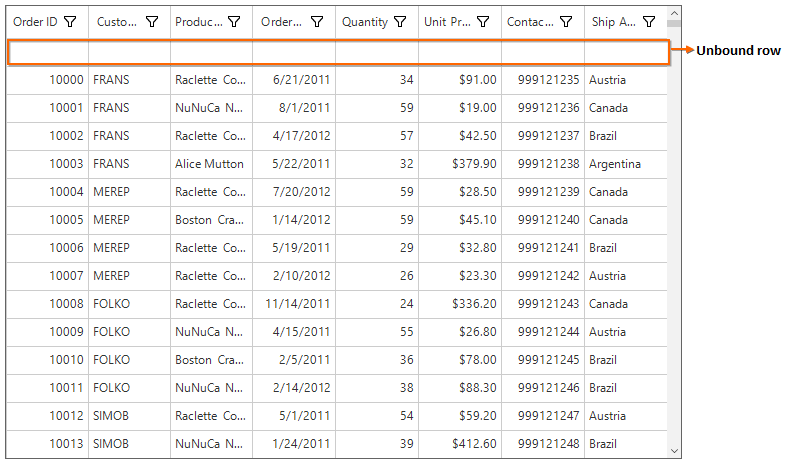
Positioning Unbound Rows
Unbound row can be placed in top or bottom of the SfDataGrid. Unbound row positioned based on GridUnboundRow.Position and GridUnboundRow.ShowBelowSummary properties.
Below table shows the unbound row positioning based on property settings of Position and ShowBelowSummary.
|
UnboundRow Position |
ShowBelowSummary |
Position in DataGrid |
| Top | True |
Unbound row placed at top, right above the record rows. In this position, unbound row is selectable and editable . |
| Top | False |
Unbound row placed at top, right next to Header row. In this position, unbound row is not selectable, not editable andfrozen when scrolling. |
| Bottom | True |
Unbound row placed at bottom of SfDataGrid. In this position, unbound row is not selectable ,not editable andfrozen when scrolling. |
| Bottom | False |
Unbound row placed at bottom, right below record rows. In this position, unbound row is selectable andeditable . |
// Add the unbound row at top and above the summary row.
this.sfDataGrid.UnboundRows.Add(new GridUnboundRow() { Position = VerticalPosition.Top, ShowBelowSummary = false });
// Add the unbound row at top and below the summary row.
this.sfDataGrid.UnboundRows.Add(new GridUnboundRow() { Position = VerticalPosition.Top, ShowBelowSummary = true });
// Add the unbound row at bottom and below the summary row.
this.sfDataGrid.UnboundRows.Add(new GridUnboundRow() { Position = VerticalPosition.Bottom, ShowBelowSummary = true });
// Add the unbound row at bottom and above the summary row.
this.sfDataGrid.UnboundRows.Add(new GridUnboundRow() { Position = VerticalPosition.Bottom, ShowBelowSummary = false });' Add the unbound row at top and above the summary row.
Me.sfDataGrid.UnboundRows.Add(New GridUnboundRow() With {.Position = VerticalPosition.Top, .ShowBelowSummary = False})
' Add the unbound row at top and below the summary row.
Me.sfDataGrid.UnboundRows.Add(New GridUnboundRow() With {.Position = VerticalPosition.Top, .ShowBelowSummary = True})
' Add the unbound row at bottom and below the summary row.
Me.sfDataGrid.UnboundRows.Add(New GridUnboundRow() With {.Position = VerticalPosition.Bottom, .ShowBelowSummary = True})
' Add the unbound row at bottom and above the summary row.
Me.sfDataGrid.UnboundRows.Add(New GridUnboundRow() With {.Position = VerticalPosition.Bottom, .ShowBelowSummary = False})Below screen shot shows different unbound rows placed in all possible positions,
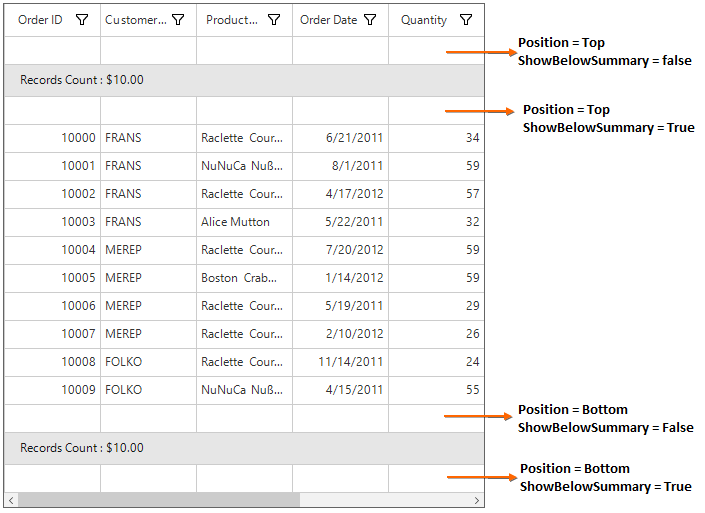
Populating Data for Unbound Rows
The data for the unbound row can populated by handling QueryUnboundRowInfo event of SfDataGrid. This event occurs for each cell in unbound row whenever the row gets refreshed. QueryUnboundRowInfoArgs of the QueryUnboundRowInfo event provides information about the cell triggered this event.
The QueryUnboundRowInfoArgs.Value property can be get or set based on the UnboundAction. If UnboundAction is QueryData then the value can set for display. If the UnboundAction is CommitData then able to get the edited value.
//Select some records in SfDataGrid.
this.sfDataGrid.SelectedItems.Add(data.OrdersListDetails[2]);
this.sfDataGrid.SelectedItems.Add(data.OrdersListDetails[3]);
this.sfDataGrid.SelectedItems.Add(data.OrdersListDetails[4]);
//Raise the QueryUnboundRowInfo event
this.sfDataGrid.QueryUnboundRowInfo += sfDataGrid_QueryUnboundRowInfo;
void sfDataGrid_QueryUnboundRowInfo(object sender, QueryUnboundRowInfoArgs e)
{
if (e.UnboundAction == UnboundActions.QueryData)
{
if (e.RowColumnIndex.ColumnIndex == 0)
{
e.Value = (sfDataGrid.SelectedItems.OrderBy(item => (item as OrderInfo).OrderID).Last() as OrderInfo).OrderID;
e.Handled = true;
}
else if (e.RowColumnIndex.ColumnIndex == 2)
{
e.Value = (sfDataGrid.SelectedItems.First(item => (item as OrderInfo).ProductName.Contains("R")) as OrderInfo).ProductName;
e.Handled = true;
}
}
}'Select some records in SfDataGrid.
Me.sfDataGrid.SelectedItems.Add(data.OrdersListDetails(2))
Me.sfDataGrid.SelectedItems.Add(data.OrdersListDetails(3))
Me.sfDataGrid.SelectedItems.Add(data.OrdersListDetails(4))
'Raise the QueryUnboundRowInfo event
AddHandler Me.sfDataGrid.QueryUnboundRowInfo, AddressOf sfDataGrid_QueryUnboundRowInfo
void sfDataGrid_QueryUnboundRowInfo(Object sender, QueryUnboundRowInfoArgs e)
If e.UnboundAction = UnboundActions.QueryData Then
If e.RowColumnIndex.ColumnIndex = 0 Then
e.Value = (TryCast(sfDataGrid.SelectedItems.OrderBy(Function(item) (TryCast(item, OrderInfo)).OrderID).Last(), OrderInfo)).OrderID
e.Handled = True
ElseIf e.RowColumnIndex.ColumnIndex = 2 Then
e.Value = (TryCast(sfDataGrid.SelectedItems.First(Function(item) (TryCast(item, OrderInfo)).ProductName.Contains("R")), OrderInfo)).ProductName
e.Handled = True
End If
End If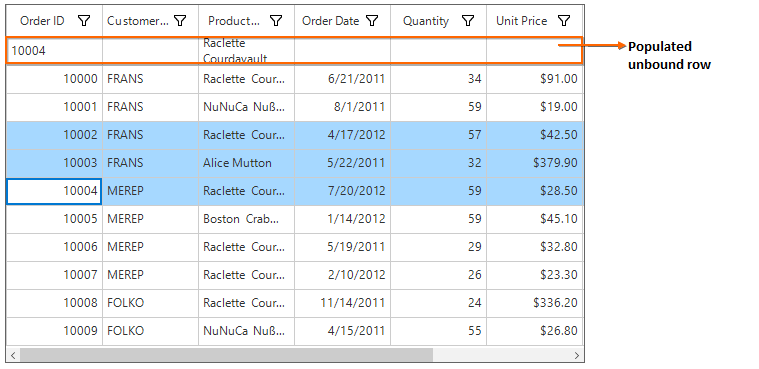
Refreshing the Unbound Rows at Runtime
The unbound rows can be add or remove using UnboundRows property which reflects in UI immediately. The QueryUnboundRowInfo event for the unbound row cells at runtime by invalidating the unbound row by calling SfDataGrid.InValidateUnboundRow method.
this.sfDataGrid.InValidateUnboundRow(sfDataGrid.UnboundRows[0], true);
this.sfDataGrid.TableControl.Invalidate();this.sfDataGrid.InValidateUnboundRow(sfDataGrid.UnboundRows[0], true);
this.sfDataGrid.TableControl.Invalidate();Editing in Unbound Rows
Cancel the Editing for Unbound Row Cell
The editing of unbound row cell can cancel by handling the SfDataGrid.CurrentCellBeginEdit event with the help of SfDataGrid.GetUnboundRow method and row index.
sfDataGrid.CurrentCellBeginEdit += dataGrid_CurrentCellBeginEdit;
void dataGrid_CurrentCellBeginEdit(object sender, CurrentCellBeginEditEventArgs args)
{
var unboundRow = sfDataGrid.GetUnboundRow(args.DataRow.Index);
if (unboundRow == null)
return;
args.Cancel = true;
}AddHandler sfDataGrid.CurrentCellBeginEdit, AddressOf dataGrid_CurrentCellBeginEdit
Private Sub dataGrid_CurrentCellBeginEdit(ByVal sender As Object, ByVal args As CurrentCellBeginEditEventArgs)
Dim unboundRow = sfDataGrid.GetUnboundRow(args.DataRow.Index)
If unboundRow Is Nothing Then
Return
End If
args.Cancel = True
End SubSaving Edited Unbound Row Cell Value to External Source
The edited value of unbound row cell can get from QueryUnboundRowInfoArgs.Value property of QueryUnboundRowInfo event when UnboundAction is CommitData.
void sfDataGrid_QueryUnboundRowInfo(object sender, QueryUnboundRowInfoArgs e)
{
if (e.UnboundAction == UnboundActions.CommitData)
{
var editedValue = e.Value;
}
}Private Sub sfDataGrid_QueryUnboundRowInfo(ByVal sender As Object, ByVal e As QueryUnboundRowInfoArgs)
If e.UnboundAction = UnboundActions.CommitData Then
Dim editedValue = e.Value
End If
End SubAppearance
The appearance of the unbound row can be customized by using the UnboundRowStyle property.
sfDataGrid.Style.UnboundRowStyle.BackColor = Color.LightGray;
sfDataGrid.Style.UnboundRowStyle.TextColor = Color.Red;sfDataGrid.Style.UnboundRowStyle.BackColor = Color.LightGray
sfDataGrid.Style.UnboundRowStyle.TextColor = Color.Red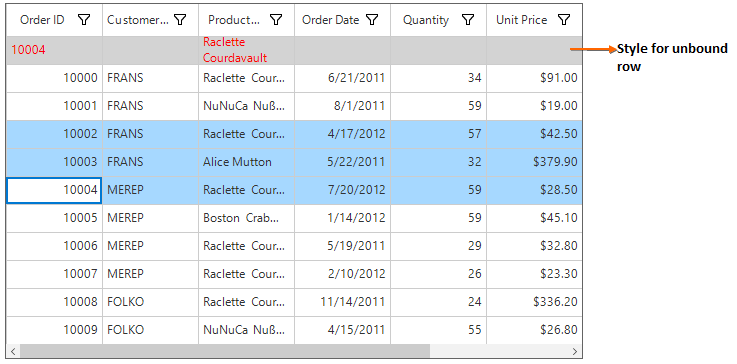
Customizing the Unbound Row’s Behavior
SfDataGrid allows to customize the operations like key navigation and UI related interactions by overriding the corresponding renderer associated with the unbound row cell. Each renderer have set of virtual methods for handling the behaviors. Creating new renderers also supported.
The renderer of unbound row cell defined by QueryUnboundRowInfoArgs.CellType property in the QueryUnboundRowInfo event. If the QueryUnboundRowInfoArgs.CellType not defined then the UnboundRowCell set as default cell type.
Overriding Existing CellType
SfDataGrid allows to customize the unbound row cell behavior by overriding existing renderer and replace the default one in UnboundRowCellRenderers.
public class GridUnboundRowCellTextBoxRendererExt : GridUnboundRowCellRenderer
{
protected override void OnEditingComplete(DataColumnBase dataColumn, TextBox currentRendererElement)
{
base.OnEditingComplete(dataColumn, currentRendererElement);
}
protected override void OnInitializeEditElement(DataColumnBase column, RowColumnIndex rowColumnIndex, TextBox uiElement)
{
base.OnInitializeEditElement(column, rowColumnIndex, uiElement);
uiElement.ForeColor = Color.Red;
}
}Public Class GridUnboundRowCellTextBoxRendererExt
Inherits GridUnboundRowCellRenderer
Protected Overrides Sub OnEditingComplete(ByVal dataColumn As DataColumnBase, ByVal currentRendererElement As TextBox)
MyBase.OnEditingComplete(dataColumn, currentRendererElement)
End Sub
Protected Overrides Sub OnInitializeEditElement(ByVal column As DataColumnBase, ByVal rowColumnIndex As RowColumnIndex, ByVal uiElement As TextBox)
MyBase.OnInitializeEditElement(column, rowColumnIndex, uiElement)
uiElement.ForeColor = Color.Red
End Sub
End ClassIn the below code default renderer replaced using the above custom renderer in SfDataGrid.UnboundRowCellRenderers.
sfDataGrid.UnboundRowCellRenderers.Remove("UnboundRowCell");
sfDataGrid.UnboundRowCellRenderers.Add("UnboundRowCell", new GridUnboundRowCellTextBoxRendererExt());sfDataGrid.UnboundRowCellRenderers.Remove("UnboundRowCell")
sfDataGrid.UnboundRowCellRenderers.Add("UnboundRowCell", New GridUnboundRowCellTextBoxRendererExt())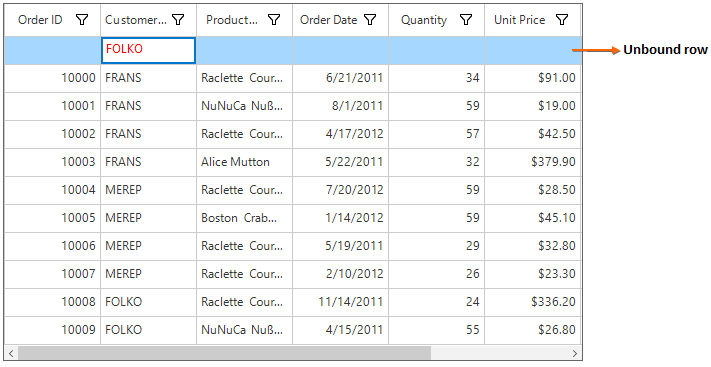
Custom Renderer
SfDataGrid allows to customize the unbound row cell by creating new renderer, deriving from GridUnboundRowCellRenderer and setting the QueryUnboundRowInfoArgs.CellType property.
Below code creates DatePickerRenderer to load the DatePicker as editor element in the first cell of unbound row.
// The custom unbound row cell renderer.
public class DatePickerRenderer : GridVirtualizingCellRendererBase<DateTimePicker>
{
public DatePickerRenderer()
{
}
protected override DateTimePicker OnCreateEditUIElement()
{
return new DateTimePicker();
}
protected override void OnInitializeEditElement(DataColumnBase dataColumn, RowColumnIndex rowColIndex,
DateTimePicker uiElement)
{
SfDataGrid DataGrid = dataColumn.UnboundRowInfo.OriginalSender as SfDataGrid;
DateTime time = DateTime.Now;
if(dataColumn.UnboundRowInfo.Value != null)
DateTime.TryParse(dataColumn.UnboundRowInfo.Value.ToString(), out time);
(uiElement as DateTimePicker).Value = time;
uiElement.Tag = dataColumn;
Rectangle editorRectangle = this.TableControl.GetCellRectangle(DataGrid.CurrentCell.RowIndex,
DataGrid.CurrentCell.ColumnIndex, true);
var borderWeight = DataGrid.Style.CurrentCellStyle.BorderThickness;
var weight = GetWidthForWeight(borderWeight);
// Adjusts with border thickness for the editing control bounds.
editorRectangle = new Rectangle(editorRectangle.X + weight, editorRectangle.Y + weight, editorRectangle.Width -
(2 * weight), editorRectangle.Height - (2 * weight));
uiElement.Size = editorRectangle.Size;
uiElement.Location = editorRectangle.Location;
uiElement.AutoSize = false;
uiElement.MinimumSize = editorRectangle.Size;
uiElement.Format = DateTimePickerFormat.Long;
this.TableControl.Controls.Add(uiElement);
uiElement.Focus();
}
protected override void OnRender(
Graphics paint,
Rectangle cellRect,
string cellValue,
CellStyleInfo style,
DataColumnBase column,
RowColumnIndex rowColumnIndex)
{
SfDataGrid DataGrid = column.UnboundRowInfo.OriginalSender as SfDataGrid;
bool isEditing = DataGrid.CurrentCell != null && DataGrid.CurrentCell.RowIndex == rowColumnIndex.RowIndex
&& DataGrid.CurrentCell.ColumnIndex == rowColumnIndex.ColumnIndex && DataGrid.CurrentCell.IsEditing;
SolidBrush backColor = new SolidBrush(style.BackColor);
var fillRect = (style.HasBorders) ? cellRect : cellRect.X == 0 ? new Rectangle(cellRect.X, cellRect.Y + 1,
cellRect.Width, cellRect.Height - 1) : new Rectangle(cellRect.X + 1, cellRect.Y + 1, cellRect.Width - 1, cellRect.Height - 1);
SolidBrush textColor = new SolidBrush(style.TextColor);
GridFontInfo font = column.GridColumn.CellStyle.Font;;
StringFormat format = new StringFormat();
format.LineAlignment = StringAlignment.Center;
if (isEditing)
{
paint.FillRectangle(new SolidBrush(style.BackColor), fillRect);
this.UpdateEditElement(column, this.CurrentCellRendererElement, cellRect);
this.CurrentCellRendererElement.Update();
if (isEditing)
return;
cellValue = this.CurrentCellRendererElement.Text;
textColor = new SolidBrush(style.TextColor);
font = column.GridColumn.CellStyle.Font;
cellRect.X = style.HorizontalAlignment == HorizontalAlignment.Left
? cellRect.X + 2
: column.GridColumn.CellStyle.HorizontalAlignment == HorizontalAlignment.Right
? cellRect.X - 2
: cellRect.X;
}
////Filling BackColor
if (backColor != SystemBrushes.Window)
paint.FillRectangle(backColor, fillRect);
if (!string.IsNullOrEmpty(cellValue))
{
//Draw String
paint.DrawString(cellValue, font.GetFont(), textColor, cellRect, format);
}
format.Dispose();
base.OnRender(paint, cellRect, cellValue, style, column, rowColumnIndex);
}
public override bool CanValidate()
{
return false;
}
protected override void OnWireEditUIElement(DateTimePicker uiElement)
{
base.OnWireEditUIElement(uiElement);
uiElement.ValueChanged += uiElement_ValueChanged;
}
protected override void OnUnwireEditUIElement(DateTimePicker uiElement)
{
base.OnUnwireEditUIElement(uiElement);
uiElement.ValueChanged -= uiElement_ValueChanged;
}
void uiElement_ValueChanged(object sender, EventArgs e)
{
var datePicker = sender as DateTimePicker;
if (datePicker.Tag is DataColumn)
{
var dataColumn = datePicker.Tag as DataColumnBase;
dataColumn.UnboundRowInfo.Value = (sender as DateTimePicker).Value;
}
}
private static int GetWidthForWeight(GridBorderWeight weight)
{
int width = 1;
switch (weight)
{
case GridBorderWeight.ExtraThin:
width = 1;
break;
case GridBorderWeight.Thin:
width = 1;
break;
case GridBorderWeight.Medium:
width = 2;
break;
case GridBorderWeight.Thick:
width = 3;
break;
case GridBorderWeight.ExtraThick:
width = 4;
break;
case GridBorderWeight.ExtraExtraThick:
width = 4;
break;
}
return width;
}
protected override void OnEditingComplete(DataColumnBase dataColumn, DateTimePicker currentRendererElement)
{
dataColumn.UnboundRowInfo.Value = (this.CurrentCellRendererElement as DateTimePicker).Text;
(dataColumn.UnboundRowInfo.OriginalSender as SfDataGrid).RaiseQueryUnboundRowInfo(dataColumn.UnboundRowInfo.UnboundRow,
dataColumn.UnboundRowInfo.UnboundAction, dataColumn.UnboundRowInfo.Value,
dataColumn.UnboundRowInfo.Column, dataColumn.UnboundRowInfo.CellType, dataColumn.UnboundRowInfo.RowColumnIndex);
base.OnEditingComplete(dataColumn, currentRendererElement);
}
}' The custom unbound row cell renderer.
Public Class DatePickerRenderer
Inherits GridVirtualizingCellRendererBase(Of DateTimePicker)
Public Sub New()
End Sub
Protected Overrides Function OnCreateEditUIElement() As DateTimePicker
Return New DateTimePicker()
End Function
Protected Overrides Sub OnInitializeEditElement(ByVal dataColumn As DataColumnBase, ByVal rowColIndex As RowColumnIndex, ByVal uiElement As DateTimePicker)
Dim DataGrid As SfDataGrid = TryCast(dataColumn.UnboundRowInfo.OriginalSender, SfDataGrid)
Dim time As DateTime = DateTime.Now
If dataColumn.UnboundRowInfo.Value IsNot Nothing Then
DateTime.TryParse(dataColumn.UnboundRowInfo.Value.ToString(), time)
End If
TryCast(uiElement, DateTimePicker).Value = time
uiElement.Tag = dataColumn
Dim editorRectangle As Rectangle = Me.TableControl.GetCellRectangle(DataGrid.CurrentCell.RowIndex, DataGrid.CurrentCell.ColumnIndex, True)
Dim borderWeight = DataGrid.Style.CurrentCellStyle.BorderThickness
Dim weight = GetWidthForWeight(borderWeight)
' Adjusts with border thickness for the editing control bounds.
editorRectangle = New Rectangle(editorRectangle.X + weight, editorRectangle.Y + weight, editorRectangle.Width - (2 * weight), editorRectangle.Height - (2 * weight))
uiElement.Size = editorRectangle.Size
uiElement.Location = editorRectangle.Location
uiElement.AutoSize = False
uiElement.MinimumSize = editorRectangle.Size
uiElement.Format = DateTimePickerFormat.Long
Me.TableControl.Controls.Add(uiElement)
uiElement.Focus()
End Sub
Protected Overrides Sub OnRender(ByVal paint As Graphics, ByVal cellRect As Rectangle, ByVal cellValue As String, ByVal style As CellStyleInfo, ByVal column As DataColumnBase, ByVal rowColumnIndex As RowColumnIndex)
Dim DataGrid As SfDataGrid = TryCast(column.UnboundRowInfo.OriginalSender, SfDataGrid)
Dim isEditing As Boolean = DataGrid.CurrentCell IsNot Nothing AndAlso DataGrid.CurrentCell.RowIndex = rowColumnIndex.RowIndex AndAlso DataGrid.CurrentCell.ColumnIndex = rowColumnIndex.ColumnIndex AndAlso DataGrid.CurrentCell.IsEditing
Dim backColor As New SolidBrush(style.BackColor)
Dim fillRect = If((style.HasBorders), cellRect, If(cellRect.X = 0, New Rectangle(cellRect.X, cellRect.Y + 1, cellRect.Width, cellRect.Height - 1), New Rectangle(cellRect.X + 1, cellRect.Y + 1, cellRect.Width - 1, cellRect.Height - 1)))
Dim textColor As New SolidBrush(style.TextColor)
Dim font As GridFontInfo = column.GridColumn.CellStyle.Font
Dim format As New StringFormat()
format.LineAlignment = StringAlignment.Center
If isEditing Then
paint.FillRectangle(New SolidBrush(style.BackColor), fillRect)
Me.UpdateEditElement(column, Me.CurrentCellRendererElement, cellRect)
Me.CurrentCellRendererElement.Update()
If isEditing Then
Return
End If
cellValue = Me.CurrentCellRendererElement.Text
textColor = New SolidBrush(style.TextColor)
font = column.GridColumn.CellStyle.Font
cellRect.X = If(style.HorizontalAlignment = HorizontalAlignment.Left, cellRect.X + 2, If(column.GridColumn.CellStyle.HorizontalAlignment = HorizontalAlignment.Right, cellRect.X - 2, cellRect.X))
End If
'//Filling BackColor
If backColor IsNot SystemBrushes.Window Then
paint.FillRectangle(backColor, fillRect)
End If
If Not String.IsNullOrEmpty(cellValue) Then
'Draw String
paint.DrawString(cellValue, font.GetFont(), textColor, cellRect, format)
End If
format.Dispose()
MyBase.OnRender(paint, cellRect, cellValue, style, column, rowColumnIndex)
End Sub
Public Overrides Function CanValidate() As Boolean
Return False
End Function
Protected Overrides Sub OnWireEditUIElement(ByVal uiElement As DateTimePicker)
MyBase.OnWireEditUIElement(uiElement)
AddHandler uiElement.ValueChanged, AddressOf uiElement_ValueChanged
End Sub
Protected Overrides Sub OnUnwireEditUIElement(ByVal uiElement As DateTimePicker)
MyBase.OnUnwireEditUIElement(uiElement)
RemoveHandler uiElement.ValueChanged, AddressOf uiElement_ValueChanged
End Sub
Private Sub uiElement_ValueChanged(ByVal sender As Object, ByVal e As EventArgs)
Dim datePicker = TryCast(sender, DateTimePicker)
If TypeOf datePicker.Tag Is DataColumn Then
Dim dataColumn = TryCast(datePicker.Tag, DataColumnBase)
dataColumn.UnboundRowInfo.Value = (TryCast(sender, DateTimePicker)).Value
End If
End Sub
Private Shared Function GetWidthForWeight(ByVal weight As GridBorderWeight) As Integer
Dim width As Integer = 1
Select Case weight
Case GridBorderWeight.ExtraThin
width = 1
Case GridBorderWeight.Thin
width = 1
Case GridBorderWeight.Medium
width = 2
Case GridBorderWeight.Thick
width = 3
Case GridBorderWeight.ExtraThick
width = 4
Case GridBorderWeight.ExtraExtraThick
width = 4
End Select
Return width
End Function
Protected Overrides Sub OnEditingComplete(ByVal dataColumn As DataColumnBase, ByVal currentRendererElement As DateTimePicker)
dataColumn.UnboundRowInfo.Value = (TryCast(Me.CurrentCellRendererElement, DateTimePicker)).Text
TryCast(dataColumn.UnboundRowInfo.OriginalSender, SfDataGrid).RaiseQueryUnboundRowInfo(dataColumn.UnboundRowInfo.UnboundRow, dataColumn.UnboundRowInfo.UnboundAction, dataColumn.UnboundRowInfo.Value, dataColumn.UnboundRowInfo.Column, dataColumn.UnboundRowInfo.CellType, dataColumn.UnboundRowInfo.RowColumnIndex)
MyBase.OnEditingComplete(dataColumn, currentRendererElement)
End Sub
End ClassIn the below code newly created renderer added in SfDataGrid.UnboundRowCellRenderers
sfDataGrid.UnboundRowCellRenderers.Add("DateTimeRenderer", new DatePickerRenderer());sfDataGrid.UnboundRowCellRenderers.Add("DateTimeRenderer", New DatePickerRenderer())Below code sets the CellType as DateTimeRenderer,
void sfDataGrid_QueryUnboundRowInfo(object sender, QueryUnboundRowInfoArgs e)
{
if (e.UnboundAction == UnboundActions.QueryData)
{
if (e.Column.MappingName == "OrderDate")
{
e.CellType = "DateTimeRenderer";
e.Handled = true;
}
}
}Private Sub sfDataGrid_QueryUnboundRowInfo(ByVal sender As Object, ByVal e As QueryUnboundRowInfoArgs)
If e.UnboundAction = UnboundActions.QueryData Then
If e.Column.MappingName = "OrderDate" Then
e.CellType = "DateTimeRenderer"
e.Handled = True
End If
End If
End Sub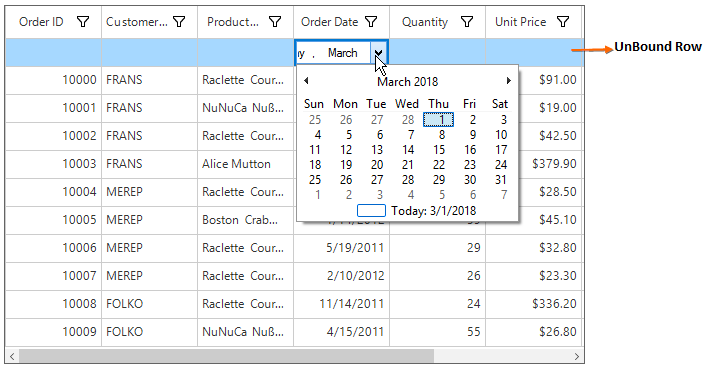
Changing Unbound Row Height
The height of unbound row can changed by using SfDataGrid.QueryRowHeight event,
sfDataGrid.QueryRowHeight += dataGrid_QueryRowHeight;
void dataGrid_QueryRowHeight(object sender, QueryRowHeightEventArgs e)
{
if (sfDataGrid.IsUnboundRow(e.RowIndex))
{
e.Height = 40;
e.Handled = true;
}
}AddHandler sfDataGrid.QueryRowHeight, AddressOf dataGrid_QueryRowHeight
Private Sub dataGrid_QueryRowHeight(ByVal sender As Object, ByVal e As QueryRowHeightEventArgs)
If sfDataGrid.IsUnboundRow(e.RowIndex) Then
e.Height = 40
e.Handled = True
End If
End Sub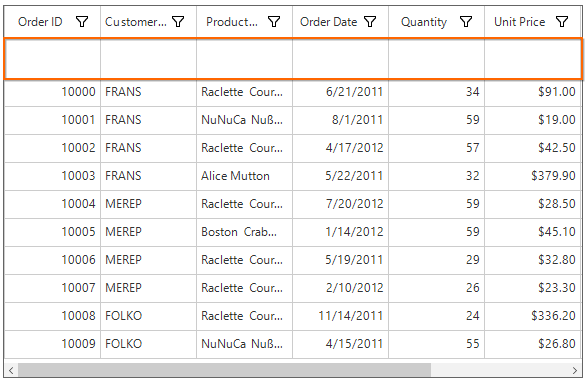
Exporting Unbound Rows
Export Unbound Rows to Excel
The unbound rows can export to excel by setting the ExcelExportingOptions.ExportUnboundRows property.
using Syncfusion.WinForms.DataGridConverter;
ExcelExportingOptions option = new ExcelExportingOptions();
option.ExportUnboundRows = true;Imports Syncfusion.WinForms.DataGridConverter
Private [option] As New ExcelExportingOptions()
[option].ExportUnboundRows = TrueExport Unbound Rows to PDF
The unbound rows can export to PDF by setting the PdfExportingOptions.ExportUnboundRows property.
using Syncfusion.WinForms.DataGridConverter;
PdfExportingOptions pdfExportingOption = new PdfExportingOptions();
pdfExportingOption.ExportUnboundRows = true;Imports Syncfusion.WinForms.DataGridConverter
Private pdfExportingOption As New PdfExportingOptions()
pdfExportingOption.ExportUnboundRows = TrueGet Unbound Rows
The unbound row of specified row index can get by using GetUnboundRow method.
sfDataGrid.GetUnboundRow(1);sfDataGrid.GetUnboundRow(1)